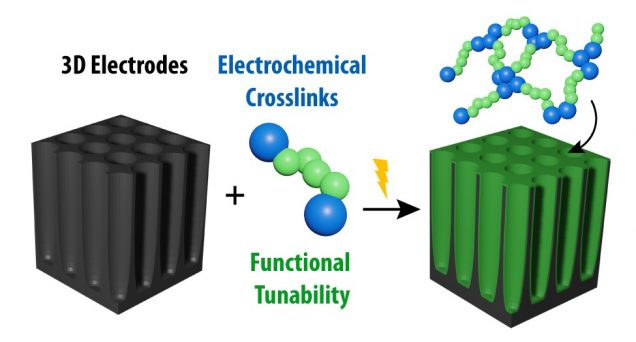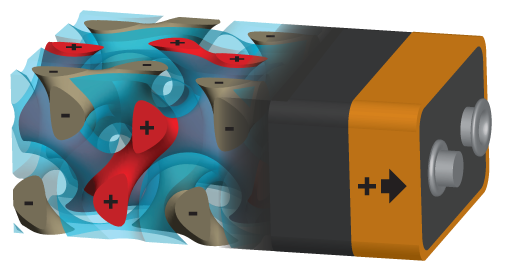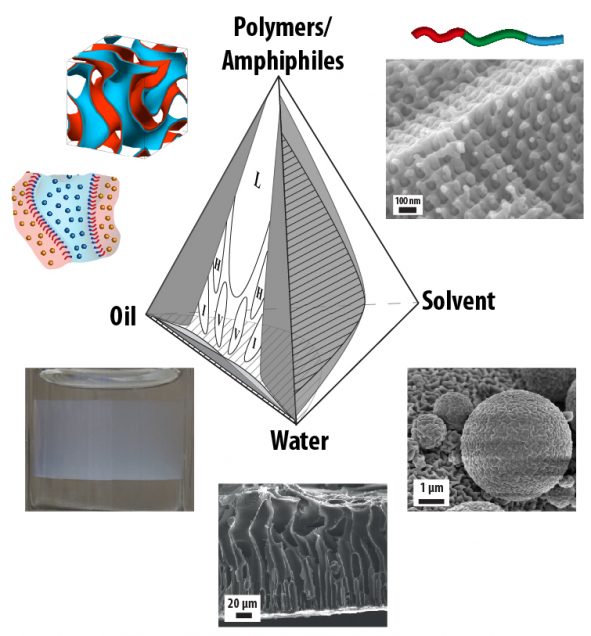Research
3-D Thin Films: Conformal Coatings on Porous Materials and Non-Planar Substrates
 The precise and conformal deposition of functional materials as sub-micron films and coatings is well-established in 2-D and on external surfaces, but existing fabrication methods struggle to uniformly coat 3-D architectures such as non-planar substrates and porous materials with mesoscale feature sizes. We study solution-based processing methods to coat a plethora of functional soft and hard materials on porous frameworks using surface-confined materials synthesis. For example, our research combines polymer chemistry and electrochemistry to fabricate functional thin films on 3-D porous conductive materials. We strive to understand the foundational mechanisms of our polymer electrodeposition paradigm to gain control over the 3-D thin film’s nanoscopic properties that are uniform over macroscopic dimensions. Such a scalable and tunable coating method enables multifunctional 3-D materials with large interphase areas with tailor-made properties of interest for energy and sustainability technologies. (Related publications)
The precise and conformal deposition of functional materials as sub-micron films and coatings is well-established in 2-D and on external surfaces, but existing fabrication methods struggle to uniformly coat 3-D architectures such as non-planar substrates and porous materials with mesoscale feature sizes. We study solution-based processing methods to coat a plethora of functional soft and hard materials on porous frameworks using surface-confined materials synthesis. For example, our research combines polymer chemistry and electrochemistry to fabricate functional thin films on 3-D porous conductive materials. We strive to understand the foundational mechanisms of our polymer electrodeposition paradigm to gain control over the 3-D thin film’s nanoscopic properties that are uniform over macroscopic dimensions. Such a scalable and tunable coating method enables multifunctional 3-D materials with large interphase areas with tailor-made properties of interest for energy and sustainability technologies. (Related publications)
Architected Materials and Devices for Advanced Energy Storage
Low-Tortuosity Electrode Architectures to Optimize Energy and Power in Batteries
We explore novel methods to fabricate rationally architected battery electrodes at application relevant scales from the nano- to the micro- and macro-scale. A particular emphasis is on understanding and optimizing the pore architecture to enhance power capabilities (e.g., charging rates) without sacrificing energy density (e.g., driving range for EVs). For example, in our recent work we demonstrate how straight open micron-sized pores in electrodes can be easily fabricated and tuned using a roll-to-roll compatible bottom-up fabrication method that is material agnostic. We further report initial results on these architectural impacts on battery performance metrics.

3-D Micro-Interdigitated Battery Architectures
Departing from the traditional 2-D layered battery design and integrating all battery components inside a 3-D structure has the potential to result in ultra-short ion diffusion distances between the electrodes in an architecture with macroscopic dimensions and high functional material density. This enables decoupling of a battery’s energy from its power density to a large degree, using rational structural design considerations. We research the fabrication methods and synthesis pathways of such complex 3-D battery architectures using bottom-up synthesis strategies, as well as their fundamental properties and limitations.
Fundamentals of Soft-Matter Self-Assembly
 We study the self-assembly of soft matter to find novel ways of creating mesoscale structures. As a bottom-up fabrication method, self-assembly enables the creation of complex architectures with characteristic feature sizes on the nanometer to micrometer scales over large volumes. The often liquid-phase-based methods enable the molding, coating, and additive assembly of mesostructured architectures in arbitrary macroscopic shapes, creating a rich variety of hierarchically complex materials and composites. We research the fundamental assembly pathways of complex molecules and fluids such as block copolymers, microemulsions, lyotropic liquid crystals, multiphase-separating and interfacial systems. Understanding complex fluidic and soft-matter behavior enables us to control the self-assembly process with spatial and temporal precision for advanced structure formation and templating of functional materials. (Related publications)
We study the self-assembly of soft matter to find novel ways of creating mesoscale structures. As a bottom-up fabrication method, self-assembly enables the creation of complex architectures with characteristic feature sizes on the nanometer to micrometer scales over large volumes. The often liquid-phase-based methods enable the molding, coating, and additive assembly of mesostructured architectures in arbitrary macroscopic shapes, creating a rich variety of hierarchically complex materials and composites. We research the fundamental assembly pathways of complex molecules and fluids such as block copolymers, microemulsions, lyotropic liquid crystals, multiphase-separating and interfacial systems. Understanding complex fluidic and soft-matter behavior enables us to control the self-assembly process with spatial and temporal precision for advanced structure formation and templating of functional materials. (Related publications)